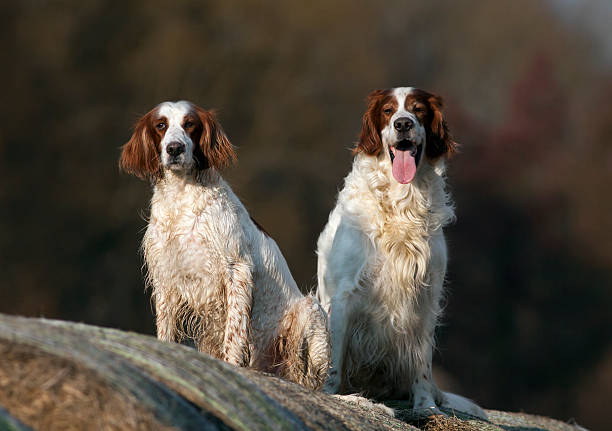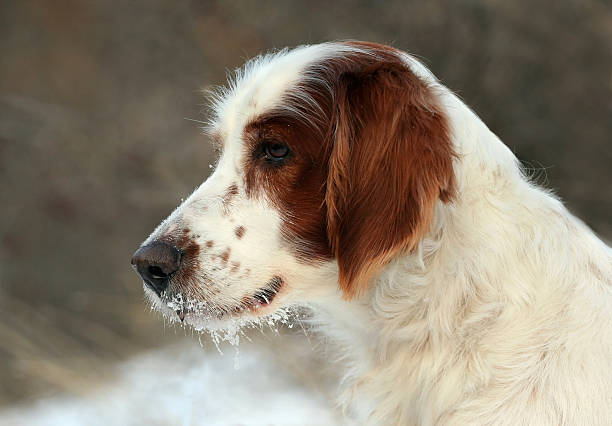Irish Red and White Setter

Breed History:
The Irish Red and White Setter is the older of the two Irish setter breeds, dating back to at least the 17th century in Ireland. Bred as a gun dog, it was prized for its ability to locate and indicate game birds with a “set,” or crouch. It was originally favoured over the solid red variant for its visibility in the field.
By the late 19th century, the breed’s popularity declined as the Irish Setter (solid red) rose in favour. The red and white variety nearly disappeared but was saved from extinction by a few dedicated breeders in the 20th century. Officially recognised by the Irish Kennel Club in 1944 and by the FCI in 1981, the breed has seen a resurgence among hunters and enthusiasts who value its heritage and working ability.
|
Gender |
Height |
Weight |
|
Male |
62-67 cm |
27-32 kg |
|
Female |
57-61 cm |
24-29 kg |
Size – Medium-Large
Life Expectancy: 11–13 years

Breed Appearance:
The Irish Red and White Setter is a distinctive and athletic breed with a strong, symmetrical build. It has a predominantly white coat with rich, solid red patches, giving it a vivid, eye-catching look in the field.
The breed has a balanced head with a square muzzle, dark expressive eyes, and long, low-set ears. The coat is silky, flat, and moderately feathered on the legs, chest, and tail. This setter moves with elegance and purpose, reflecting its field-bred stamina and grace.
Breed Type – Sporting/Gun Dog:
Bred as a versatile hunting companion, the Irish Red and White Setter is a gentle, affectionate, and loyal family dog. It thrives in homes that offer companionship and outdoor activity.
This breed is known for its eagerness to work and close connection with its handler, making it a favourite among hunters and active dog owners. It is friendly, even-tempered, and good with children and other dogs when properly socialised.

Training:
The Irish Red and White Setter is intelligent, eager to please, and generally easy to train with positive reinforcement techniques. It has a strong work ethic and enjoys structure and purpose.
Early socialisation and obedience training are important to ensure confidence and good manners. The breed responds well to consistent, patient instruction and can excel in obedience, agility, rally, and hunting trials.
Health & Care:
This breed is generally healthy but may be prone to some genetic conditions, including:
-
Hip dysplasia
-
Canine leukocyte adhesion deficiency (CLAD) – a rare immune disorder
-
Progressive retinal atrophy (PRA)
-
Von Willebrand’s disease
Reputable breeders test for these issues. Regular vet visits, good nutrition, and plenty of exercise support long-term wellness.

Living Conditions:
The Irish Red and White Setter is not suited to sedentary or apartment life without regular activity. It thrives in homes with space to run and play, ideally with a fenced yard or access to nature.
This breed needs human companionship and can suffer from separation anxiety if left alone for long periods. It adapts best to homes where it is included in daily routines and outdoor adventures.
Exercise:
A high-energy working breed, the Irish Red and White Setter needs 1.5 to 2 hours of daily exercise. Activities should include:
-
Long walks or runs
-
Off-leash play in safe areas
-
Scent work or hunting games
-
Dog sports such as agility or field trials
Without sufficient activity, it may become bored and destructive. Mental stimulation is just as important as physical exercise for this smart, active dog.
Grooming:
The breed’s moderately feathered coat is relatively low-maintenance:
-
Brush 2–3 times per week to prevent tangling and matting
-
Check ears regularly for debris or signs of infection
-
Bathe occasionally, especially after outdoor activities
-
Trim nails and clean teeth regularly
Shedding is moderate year-round but manageable with routine care.

Advantages:
-
Friendly and affectionate with family and children
-
Beautiful, distinctive red and white coat
-
Excellent hunting and field abilities
-
Intelligent and responsive to training
-
Adaptable to various dog sports and active lifestyles
-
Loyal, eager to please, and people-oriented
Disadvantages:
-
Needs substantial daily exercise and mental stimulation
-
May develop separation anxiety if left alone too long
-
Not suited to sedentary or indoor-only lifestyles
-
Some risk of genetic health issues (CLAD, PRA)
-
Can be stubborn if not trained consistently
-
Moderate shedding and ear care required

